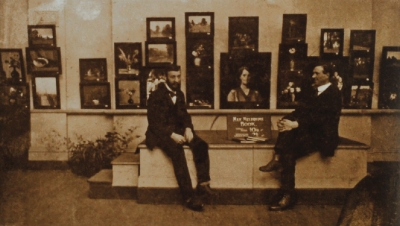HISTORY OF TMPS
106 years of history
The original Melbourne Twenty were supporters and students of tonalist Max Meldrum. Incensed at his defeat in the 1918 election for president of the Victorian Artists Society, they split from the Victorian Artists Society and regrouped at his studio in Hardware Chambers, Elizabeth Street, Melbourne.
Sharing similar ideas on painting, they formed their own exhibiting group, calling themselves ‘The Society of Twenty Melbourne Painters’. Less than a year later in 1919, the breakaway group held their first exhibition. Later, the name of the society changed to ‘The Twenty Melbourne Painters Society’. Their determination and loyalty to the group ensured its success.
The group’s origin in dissention captured the attention of media and public. Acknowledging a debt to Max Meldrum’s school of tonal realism, TMPS Founding Secretary A.M.E. Bale stated:
“We desire nothing but sincerity and a humble study of nature, from which alone all art, whether decorative or realistic, draws any enduring life.”
Members of the society have always been skilled artists, though some became more widely recognised. Sir William Dargie C.B.E., O.B.E., painted the famous ‘Wattle’ portrait of Her Majesty Queen Elizabeth II during six two-hour sittings at Buckingham Palace in 1954. Reproductions of this well-known portrait hang in many public institutions; the original is in Parliament House, Canberra.
Miss A.M.E. Bale held the position of Secretary until her death. Her will included a bequest which established a scholarship bearing her name and encouraging representational art. The Alice Bale Art Award is today considered a highly prestigious prize, perhaps the most esteemed in representational painting in Australia. The award includes a travelling scholarship which enables Australian artists to study the works of the old masters abroad. The biennial judging of the A.M.E. Bale Travelling Scholarship and associated prizes for oil and watercolour, is carried out by members of the Twenty Melbourne Painters Society. The responsibility is taken seriously, with up to three days consideration on the selection and judging of submitted works.
Other highly respected names from the group include Reshid Bey, Ernest Buckmaster, Rupert Bunny, Ron Crawford, William Frater O.B.E., Sir John Longstaff, and Clarice Beckett – all important members of the Australian artistic community.
Despite the emphasis on tradition, The Twenty Melbourne Painters Society is not aligned with strict adherence to a particular style of painting. The tradition is for quality. The group supports high standards of craftsmanship within the framework of representational tonal painting, requiring members to consolidate and improve the quality of traditional art, and promote fellowship among painters in the community. In nurturing high standards of work through professional painting, teaching and judging, they ensure that these qualities are passed on to current and future artists.
The Twenty Melbourne Painters Society has a 105 year history of exclusivity. Membership is by invitation only, after resignation or natural attrition. Artists feel honoured to be invited, and members feel privileged to be part of a group so recognised within the Australian art world.
The image below shows an exhibition at the Athenaeum Gallery in 1920, the gallery which hosted the first Twenty Melbourne Painters Society exhibition. Image courtesy of the Archives of the Melbourne Athenaeum Library.


